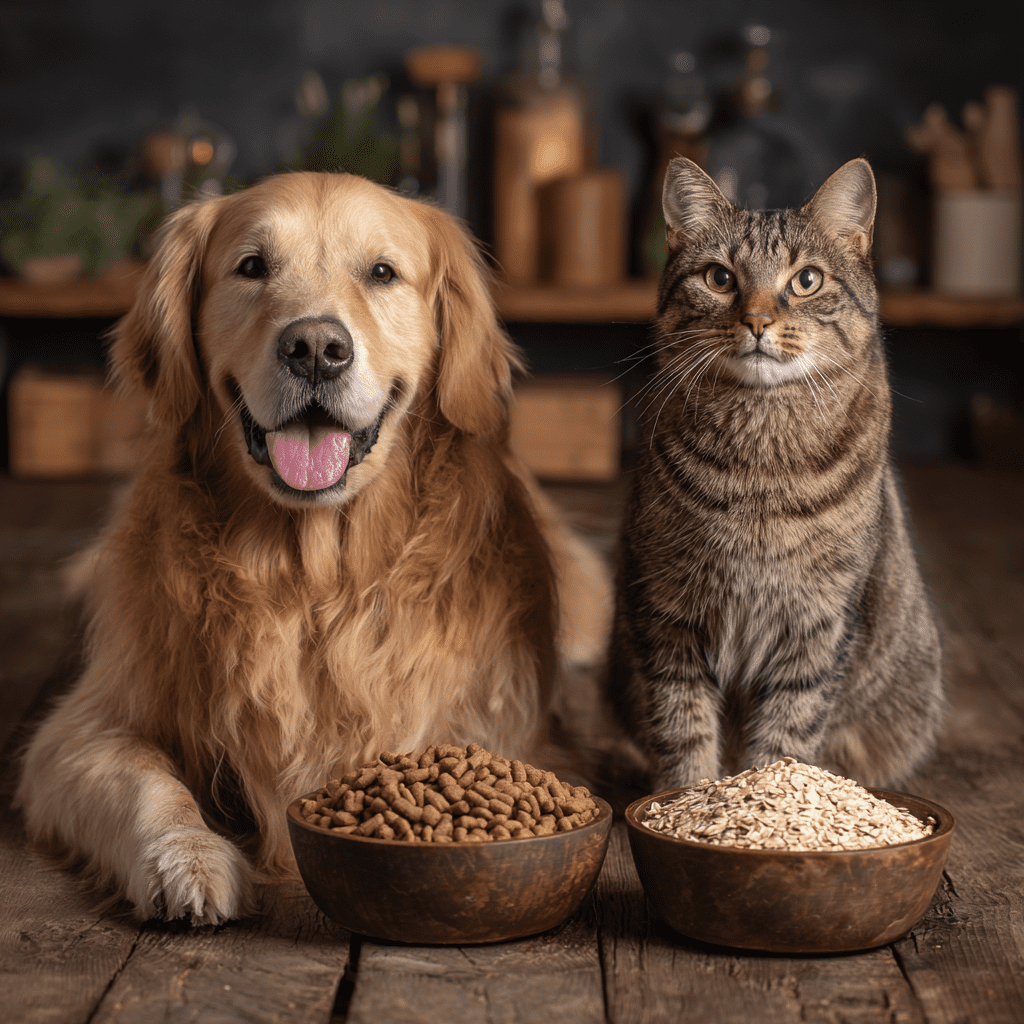Introduction: The Grain-Free Buzz
Grain-free diets for pets have exploded in popularity in recent years. Marketing campaigns often portray grains as “fillers” or unhealthy, while grain-free foods are promoted as more natural and nutritious. Many pet parents—wanting only the best for their furry companions—have switched to grain-free diets in hopes of boosting their pets’ health.
But is grain-free really better? Or is it just another trend fueled by clever marketing? In this article, we’ll explore the truth about grain-free diets for dogs and cats, uncovering benefits, risks, and what veterinarians recommend.
Why Grain-Free Diets Became Popular
- Human Food Trends Influence Pet Food
Just as gluten-free and paleo diets grew popular for humans, many owners assumed the same benefits applied to pets. - Marketing Strategies
Brands emphasized “ancestral diets,” suggesting that dogs and cats should eat like wolves or wild cats—primarily meat, no grains. - The Grain Allergy Myth
Many pet parents came to believe grains are a common cause of food allergies, skin issues, or digestive problems.
While these ideas sound convincing, the science tells a different story.
Do Dogs and Cats Really Need Grain-Free Diets?
Dogs: Natural Omnivores
Dogs have evolved alongside humans for thousands of years, adapting to eat both meat and plant-based foods. Studies show that most dogs can digest grains like rice, oats, and barley without issue.
- Whole grains provide valuable fiber, vitamins, and minerals.
- Dogs thrive on balanced diets, not exclusively meat-heavy ones.
Cats: Obligate Carnivores
Cats, unlike dogs, require animal protein as their primary food source. They don’t necessarily need grains, but most cats tolerate small amounts of cooked grains just fine.
- A small amount of grain can provide energy.
- Cats benefit more from protein quality than from excluding grains altogether.
The Benefits of Grains in Pet Diets

Grains are not simply “fillers.” When included properly, they provide:
- Digestive Support: Fiber from oats, brown rice, or barley helps regulate bowel movements.
- Essential Nutrients: B vitamins, iron, magnesium, and antioxidants.
- Weight Management: Fiber can help pets feel full and avoid overeating.
- Energy: Whole grains provide slow-release carbohydrates for active pets.
The Grain-Free Allergy Myth
Contrary to popular belief, food allergies in pets are rarely caused by grains.
- Most common allergens in dogs: beef, chicken, dairy.
- Most common allergens in cats: fish, chicken, beef.
- True grain allergies account for less than 1% of cases.
If your pet suffers from itchy skin, ear infections, or stomach issues, chances are it’s due to protein sensitivity—not grains.
Risks of Grain-Free Diets
1. Heart Disease (Dilated Cardiomyopathy – DCM) in Dogs
The FDA has investigated a potential link between grain-free diets and DCM, particularly in dogs. Many grain-free foods replace grains with legumes like peas, lentils, and potatoes. These may interfere with taurine absorption, an amino acid critical for heart health.
2. Nutritional Imbalances
Homemade or poorly formulated grain-free diets can lack essential vitamins, minerals, and amino acids. Without proper balance, pets may suffer long-term health problems.
3. Digestive Upsets
Some dogs and cats struggle to digest legume-heavy grain-free foods, leading to bloating, gas, or diarrhea.
When Grain-Free Diets May Be Necessary
While grain-free isn’t ideal for every pet, there are cases where it’s beneficial:
- Confirmed Grain Allergy or Intolerance (rare, but diagnosed by a vet).
- Certain Digestive Conditions (inflammatory bowel disease, gluten sensitivity).
- Prescription Veterinary Diets formulated grain-free for medical reasons.
👉 Unless your vet specifically recommends grain-free, there’s usually no need to avoid grains.
Choosing the Right Food for Your Pet
- Check the Ingredient List
- High-quality protein (meat, fish, poultry) should be first.
- Whole grains like brown rice or oats are a healthy inclusion.
- Beware of Fillers
- Whether grain-free or not, avoid foods heavy in corn gluten meal or excessive legumes.
- Look for AAFCO Approval
- Foods should meet AAFCO nutritional standards for complete and balanced diets.
- Consult Your Veterinarian
- Every pet has unique needs depending on age, breed, and health.
Real-Life Stories
Max the Labrador (Grain-Free Risk)
Max’s owner switched him to a grain-free diet after reading online about grain allergies. Within months, Max showed signs of lethargy and was later diagnosed with early-stage DCM. After his vet switched him back to a balanced diet with grains, Max’s condition stabilized.
Luna the Cat (No Grain Problem)
Luna, a 5-year-old tabby, thrived on a commercial food containing whole grains. She showed no signs of digestive upset, proving that grains are not harmful to every cat.
These examples highlight the importance of individualized care, not blanket diet trends.
Balanced Alternatives to Grain-Free
If you’re hesitant about grains but want a safe option:
- Limited Ingredient Diets (LID): Great for pets with food sensitivities.
- Novel Protein Diets: Duck, venison, or fish for pets allergic to common proteins.
- High-Quality Grain-Inclusive Diets: Featuring brown rice, oats, or barley paired with quality protein.
Conclusion: The Balanced Truth
Grain-free diets are not automatically healthier for pets. In fact, they can sometimes pose risks, especially when improperly formulated or chosen based on marketing hype.
The truth is:
- Most dogs and cats tolerate grains well.
- Food allergies are rarely caused by grains.
- Balanced, vet-approved diets—whether grain-inclusive or grain-free—are the best choice.
As a pet parent, your goal should be to provide complete, balanced nutrition, not just to follow the latest food trend.
